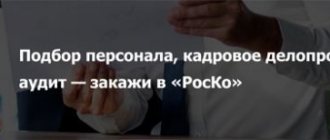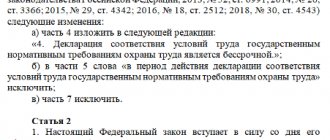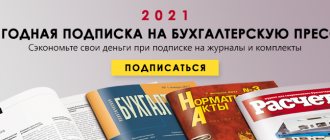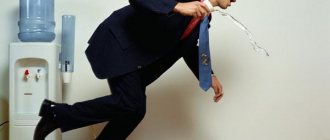The need to assess the conditions in which office employees work has long been questionable: production factors affecting their performance and health were regarded as insignificant compared to those affecting, say, installers or slingers. Regulatory documents governing workplace certification did not take into account the nuances of the work of clerks or managers. But now the procedure for conducting a special assessment of working conditions in Russia is regulated by the provisions of Federal Law No. 426-FZ of December 28, 2013. Its requirements are the same for all categories of jobs. When asked whether it is necessary to carry out SOUT for office workers, the Ministry of Labor answers clearly: it is necessary. But conducting a special assessment in offices has specifics that should be taken into account.
- Simplified special assessment
- Harmful working conditions for office workers
Stage 1. Looking for a performer
The assessment is carried out by a third party, with which the employer must enter into an agreement. The company must be included in a special register of the Ministry of Labor.
When choosing an appraiser, you can focus on a standard contract for the provision of services for conducting a special assessment of working conditions. This is Appendix No. 1 to Order of the Ministry of Labor dated December 24, 2021 No. 834n. It is mandatory for public sector organizations and municipal enterprises to use it. Everyone else can take this document as a basis and make their own changes to it.
When choosing a contractor and concluding a contract, it is recommended to pay attention to the following aspects:
- duration of work;
- cost - it depends on the number of workplaces inspected and harmful labor factors;
- assistance with regulatory documents.
Unscheduled assessment
Such an operation can be carried out regardless of the results of the previous check and can be initiated in the following situations:
- Introduction of an additional new workplace;
- Presence of motivated claims against the employer from the labor inspectorate;
- Requirements of the trade union organization;
- Modification of production processes by updating equipment or using a new variety of components;
- Injury at work;
- Early retirement, taking into account harmful working conditions.
The results of workplace control are valid for a 5-year period. In the absence of data indicating the harmfulness of production, the specified period is extended automatically. The period begins to count from the moment of the reporting entry on the implementation of the SOUT. However, if the organization has dangerous/harmful labor criteria, the audit will be carried out in full.
Stage 2. We prepare documents for carrying out SOUT
First of all, you need to draw up documents regulating the special assessment, namely:
- Order on the approval of the commission for carrying out special assessment and assessment. It must have an odd number of members. The commission is headed by the head of the employer.
Order to conduct a special assessment - Schedule conducting a special assessment:
Schedule for special assessment of working conditions - List of all jobs. SOUT is not carried out in relation to employees who work from home or remotely, as well as citizens hired under the GPC who do not have individual entrepreneur status.
Many organizations that are faced with a special assessment of working conditions for the first time do not know how to correctly draw up these documents. You can use ready-made templates or seek the help of appraiser specialists.
If the organization is large, then filling out the list of jobs may take quite a long time. It is necessary to include absolutely all employees , indicating their full name, position, SNILS, working hours (in the office and outside), equipment used in the work process, other tools and equipment.
However, not all jobs included in the list may be assessed. Some of them may be considered similar , which will allow us to evaluate only 20% of them, but not less than 2 . It will be up to specialists from the appraising organization to decide whether certain jobs are similar.
For example, 5 accountants work in the same room, have the same working hours and generally perform the same functions. In such a situation, only 2 jobs out of 5 can be evaluated, which will significantly reduce costs.
Deadlines and responsibilities
A special assessment of working conditions must be carried out at least once every 5 years. SOUT norms have been in force since 2014. Therefore, for those who have not yet completed the SOUT, the deadline for conducting it is December 31, 2018.
In some cases, unscheduled SOUT is provided: for example, when replacing equipment, changing technological processes, using new materials or new protective equipment, as well as if an accident occurred at work, an occupational disease was detected, or the organization received an appropriate order from a labor inspector or a reasoned requirement trade union.
A special assessment must also be carried out for newly created jobs within 12 months.
For violation of the legislation on SOUT, fines are provided: for officials and individual entrepreneurs - from 5 to 10 thousand rubles, for legal entities - from 60 to 80 thousand rubles.
Stage 3. Getting ready for SOUT
It is necessary to notify all departments of the company about the upcoming workplace assessment and provide inspectors with access to all premises. If we talk about the office, the main parameter here is illumination . Therefore, you should make sure that all lamps are working properly. If employees use computer equipment (and monitors are a source of harmful radiation), you need to prepare documents for it.
Note! The surface of the working table must be illuminated in accordance with the hygienic standards of SanPiN. Without taking into account the light from a table lamp, the illumination standard is 300 lux . If it is a little smaller, about 260-280 lux, you can organize combined lighting, that is, install a table lamp.
Key points of SOUT
Responsibility for conducting the assessment rests with the employer. Everyone who has hired employees, regardless of their form of ownership, is required to carry it out.
Based on the assessment results, each workplace is assigned a certain hazard class (from 1st to 4th). For failure to conduct an assessment, violation of its deadlines or procedure, penalties are provided (5-10,000 rubles for individual entrepreneurs, 60-80,000 rubles for legal entities) up to the suspension of activities for 3 months.
4 classes of working conditions
The first one is optimal. Harmful factors are absent or within normal limits.
The second is acceptable. There is exposure to harmful factors, but their consequences are compensated by rest.
The third is harmful. Permissible standards for exposure to harmful factors are exceeded. Occupational diseases may occur.
Fourth - dangerous. The worker's life is in constant danger.
Previously, instead of SOUT, certification of workplaces was carried out. But its validity period (5 years) has come to an end, since the last time it was carried out was in 2013. Accordingly, before the onset of 2021, the following must undergo a scheduled and unscheduled special labor assessment:
- everyone who is supposed to do this due to the validity period,
- those who did not have time to do it at all before;
- new businesses;
- enterprises whose working conditions have changed;
- employers who have had accidents or occupational diseases;
- other employers for whom this procedure is provided for by law.
Stage 4. We participate in measurements and eliminate shortcomings along the way
When everything is ready, specialists from the assessing organization must walk around the premises and check the workplaces, measuring the influence of harmful factors. In this case, one of the members of the SOUT commission must be present. It is recommended to draw up a table in which to enter the workplaces being checked and make notes.
In each room, experts make a staff seating plan and assign a serial number to each workplace. Working conditions in an office are assessed primarily in terms of the lighting of the place. Therefore, experts check : the height of the ceiling in the room, the power of the overhead lighting, the level of illumination without taking into account daylight (depending on the time of year, measurements are taken in the early morning or with the windows curtained).
By carrying out SOUT in the office, the appraiser’s specialists often allow the defects to be corrected on the spot. For example, the illumination of the workplace can be improved by installing more powerful lamps or adding light sources. As a result, job class outcomes will improve.
Procedure for conducting a special assessment
Carrying out SOUT is charged to legal entities and individual entrepreneurs with permanent employees. The legislation allows you to check both one and the same type of work places. Monotonous places of work of office employees or cars of the same make and year of manufacture are not inspected in full; it is enough to check 2-3 objects. Based on the results of the audit, a conclusion is drawn on all inspected objects.
To determine the number of objects to be surveyed, their location (near a window, in the basement, in the open air, etc.) and the environment (presence of air conditioning, quality of lighting, heating, etc.) also influence. If it is possible to group workplaces based on similar characteristics, they can also be surveyed individually.
They do not require an assessment of the working conditions of non-staff personnel, people engaged in home work, or personal vehicles used for official purposes.
Stage 5. Approve the report on SOUT
When all measurements have been made, the appraising organization sums up the results and draws up a report on the SOUT (form from Order of the Ministry of Labor dated January 24, 2014 No. 33n). It consists of the following parts:
- Information about the performer.
- List of jobs.
- Special assessment card. Compiled for each workplace (indicating the number and numbers of similar ones), includes information about the equipment used, harmful and dangerous factors, guarantees and compensation, as well as recommendations for improving working conditions.
- Protocol for assessing production factors.
- Summary sheet of special assessment.
- List of activities that will help improve working conditions.
- Conclusions of the appraisers.
The report must be signed by all members of the SOUT Commission and approved by the chairman.
Using the results of the SOUT
Within 3 days from the date of approval, the customer of the SOUT must notify the organization conducting the research about this and send a copy of the approved document to its address.
The employer must familiarize employees with the results of the SOUT within 30 calendar days from the date of approval of the report (Clause 5, Article 15 of Law 426-FZ).
Employees whose jobs are recognized as hazardous have the right to various benefits and compensation provided by law (preferential pension, additional payments to the tariff rate, shortened working hours, additional leave, etc.)
Within the same time frame (30 days), the employer must post the results of the SOUT on its website. Information about established classes for workplaces and ongoing labor protection measures is subject to publication.
For workplaces for which undesirable production factors have not been identified, or for workplaces classified as class 1 or 2, the employer, within 30 working days, submits a declaration of conformity of working conditions to the regional division of the Ministry of Labor (Article 11 of Law 426-FZ, order of the Ministry of Labor RF dated 02/07/2014 No. 80n).
The employer must also notify the Federal Social Insurance Fund of the Russian Federation about the results of the special assessment (subclause 18, clause 2, article 17 of Law No. 125-FZ of July 24, 1998 “On Compulsory Social Insurance...”). The Social Insurance Fund uses this information to make decisions about discounts or premiums to the insurance rate for a given employer.
In addition, a specialized organization enters information about the results of the special assessment system into the state information system (Article 18 of Law 426-FZ).
Distribution of harmful and dangerous conditions by class
The special assessment carried out in accordance with Federal Law No. 426 of December 28, 2013, involves dividing conditions into classes. During the audit period, the following are taken into account:
- The presence of substances harmful to human life and health used in production, as well as machines and equipment;
- Final report based on the results of a previous special inspection or identical surveys, checks and measurements;
- Incidents resulting in injuries as a result of production activities under the influence of hazardous working conditions;
- Are there any separate requests from full-time employees to conduct certification or special assessment of objects?
If causes creating a real danger are identified, research is carried out to classify them and include them in the final report. Working conditions are divided into 4 classes:
- Optimal in the complete absence of harmful factors or if the latter comply with current sanitary and hygienic standards.
- Acceptable when a special assessment has revealed harmful influences, but the latter do not cause much harm. The consequences resolve themselves during the employee’s rest.
- Harmful, occurring when the established standards are significantly exceeded and entailing a long period of human recovery. Certification allows for the possibility of manifestation of occupational diseases of varying severity.
- Dangerous conditions that create a real threat to the life of the employee.
Results of the special assessment
Based on the results of the special inspection, on the basis of Part 1 of Article 15 of Part 1 of Federal Law No. 426, a report is drawn up. It has official status and must contain information:
- Name of the institution that performed the examination.
- Certification of workplaces inspected during the inspection;
- Verification procedure;
- Acts of all studies;
- Conclusion of certification experts.
Company employees study the report no later than a month from the time of preparation.





